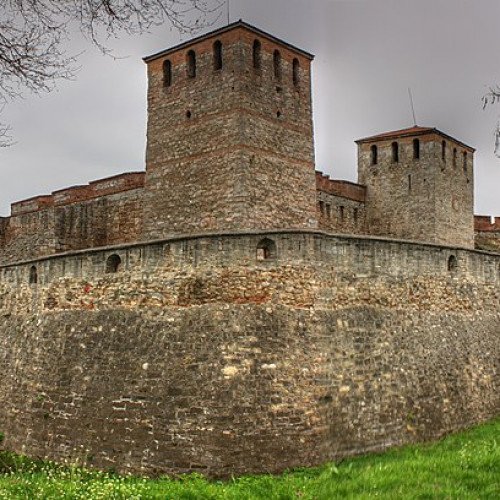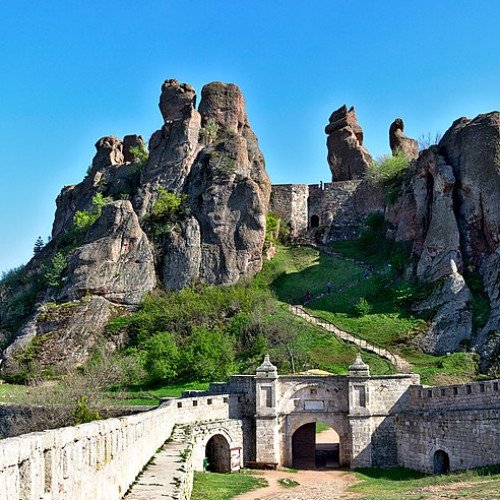Castles of "Bulgaria" BABA VIDA vs BELOGRADCHIK FORTRESS

BABA VIDA
Baba Vida (Bulgarian: Баба Вида) is a medieval fortress in Vidin in northwestern Bulgaria and the town's primary landmark. It consists of two concentric curtain walls and about nine towers of which three are preserved to their full medieval height, including the original battlements, and is said to be the only entirely preserved medieval castle in the country. Baba Vida is 39 metres (128 ft) above sea level. The construction of the fortress began in the 10th century at the place of the Ancient Roman castell Bononia. The building of Baba Vida is tied to a legend, according to which a Danubian Bulgarian king who ruled at Vidin had three daughters: Vida, Kula and Gamza. Prior to his death, he divided his realm among the three. Vida, the eldest, was given Vidin and the lands north to the Carpathians, Kula was awarded Zaječar and the Timok Valley, and Gamza was to rule the lands west up to the Morava. Although Gamza and Kula married to drunkard and warlike nobles, Vida remained unmarried and built the fortress in her city. The name of the castle means "Granny Vida". Baba Vida served as Vidin's main defensive installation during the course of the Middle Ages and acted as the most important fortress of northwestern Bulgaria. The Baba Vida stronghold withstood an eight-month-long siege by Byzantine forces led by Basil II, but was destroyed and once again erected during the rule of Ivan Stratsimir (1356-1396), as whose capital it served. Between 1365 and 1369, the fortress was in Hungarian hands. Vidin was suddenly attacked by the forces of Louis I of Hungary, but it took several months to conquer Baba Vida. In 1369, Ivan Sratsimir managed to regain control of his capital, albeit having to remain under Hungarian overlordship.
Statistics for this Xoptio

BELOGRADCHIK FORTRESS
The Belogradchik Fortress (Bulgarian: Белоградчишка крепост, Belogradchishka krepost), also known as Kaleto (Калето, "the fortress" from Turkish kale), is an ancient fortress located on the north slopes of the Balkan Mountains, close to the northwestern Bulgarian town of Belogradchik and is the town's primary cultural and historical tourist attraction, drawing, together with the Belogradchik Rocks, the main flow of tourists into the region. It is one of the best-preserved strongholds in Bulgaria and a cultural monument of national importance. The fortress's walls are over 2 metres (6.6 ft) thick in the foundation and reaching up to 12 m (39 ft) in height. Three separate fortified yards exist that are connected with each other through gates. The fortress has a total area of 10,210 square metres (109,900 sq ft). The Belogradchik Fortress was reconstructed to later become a proclaimed cultural monument. It is managed by the local historical museum authority. The initial fortress was constructed during the time when the region was part of the Roman Empire. The rock formations in the area served as a natural protection, as fortified walls were practically only built from the northwest and southeast, with the yard being surrounded by rocks up to 70 m (230 ft) high from the other sides. Initially, the Belogradchik Fortress served for surveillance and not strictly defense. Bulgarian tsar of Vidin Ivan Stratsimir extended the old fortress in the 14th century, building fortified garrisons in front of the existing rock massifs. During Stratsimir's rule, the Belogradchik Fortress became one of the most important strongholds in the region, second only to the tsar's capital fortress of Vidin, Baba Vida. During the Ottoman conquest of Bulgaria, the fortress was captured by the Ottomans in 1396. They were forced to further expand the stronghold due to the intensified hajduk and insurrectionist activity in the region. Considerable changes to the fortress were made in the early 19th century. These changes were typical for the Ottoman castle architecture of the period, a full reorganization being carried out, as well as additional expansion. Typically European elements were added to the Belogradchik Fortress owing to the French and Italian engineers that participated in the expansion. The stronghold had an important role in the Ottoman suppression of the Bulgarian Belogradchik Uprising of 1850. It was last used in warfare during the Serbo-Bulgarian War in 1885.